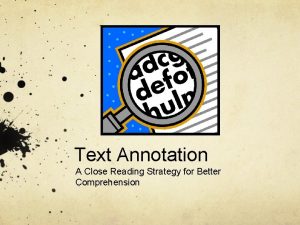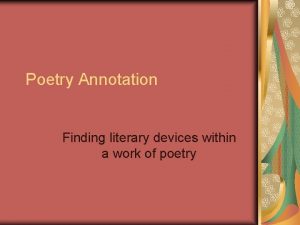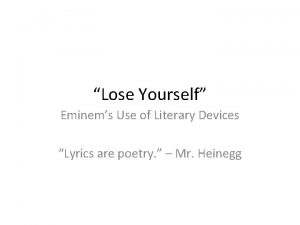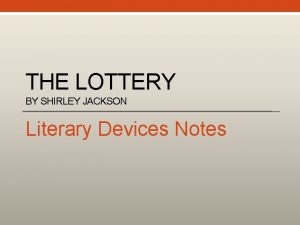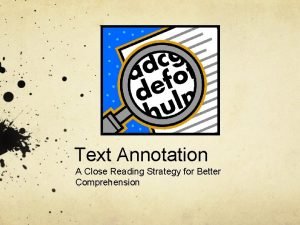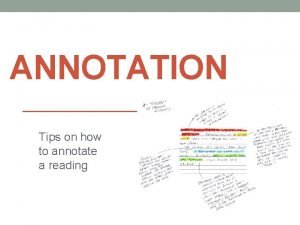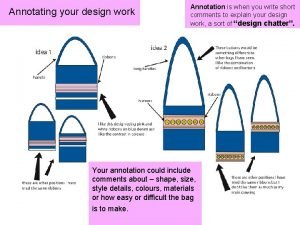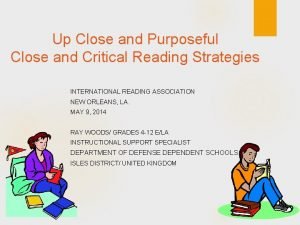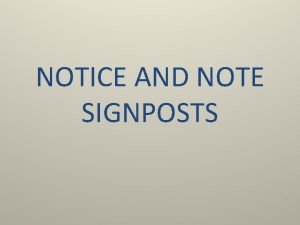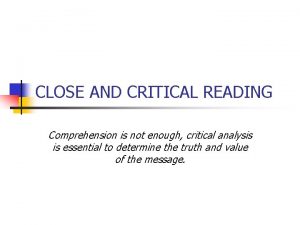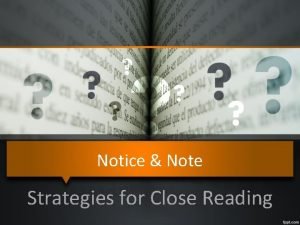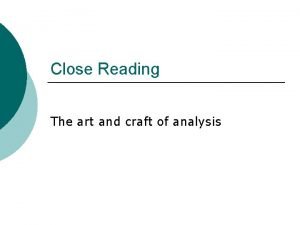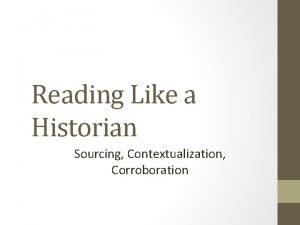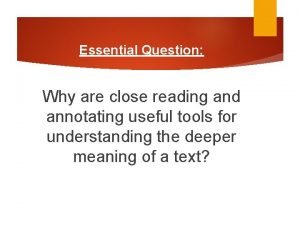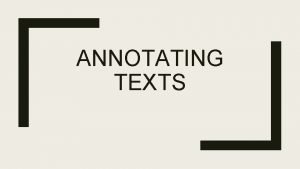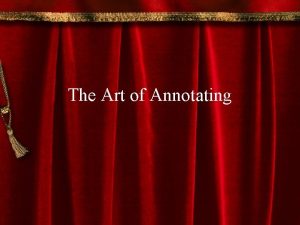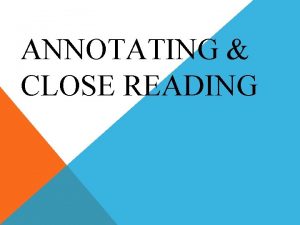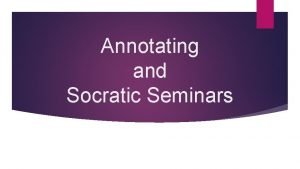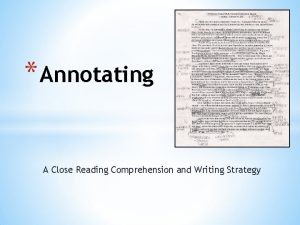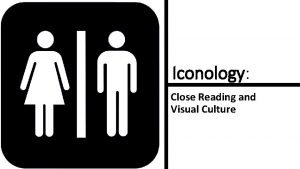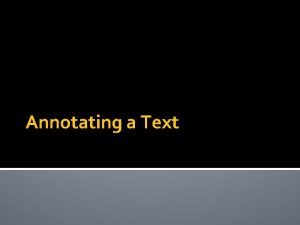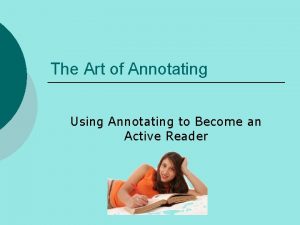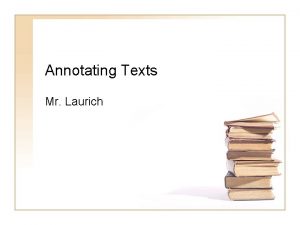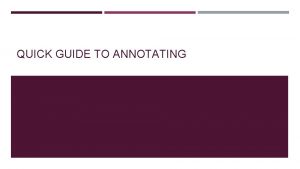Essential Question Why are close reading and annotating



















- Slides: 19

Essential Question: Why are close reading and annotating useful tools for understanding the deeper meaning of a text?

What is Close Reading? Close Reading means annotating and analyzing a text to construct meaning Focus only on the words that are there – NOT your prior knowledge of the topic

Read the Text More Than Once First read: summarize plot events (the “WHAT? ”) Second read: look at author’s craft (the “HOW? ”) Final read: determine meaning of text (the “SO WHAT? ”)

What are Annotations? Brief notes you make while independently reading to help you engage with the text. Use a highlighter and pen/pencil (or Post-It notes, if you can’t write in the book) Annotations are NOT just a summary of the text

Why Should I Annotate? Rather than have a teacher tell you what to take notes on, you make observations, ask questions, and create connections while reading. Annotating is a personal, effective way to increase your understanding. Your annotations will not be the same as someone else’s. It will help to guide class discussions and activities.

Types of Annotations Predictions about the story (using textual evidence for support) Observations about characters/situations Confusing, surprising, or interesting moments Open-ended questions Important quotations Inferences (reading between the lines) Connections that help you better understand the text Text-to-self Text-to-world Author’s craft: tone, mood, figurative language, structure, diction, etc.

Check for Understanding Let’s do a sample annotation practice together, using the first page of Anthem.

Annotating During Anthem During our reading of the novel, you will be writing two sticky notes per chapter, Stickies will be checked on the day each chapter is due At the end of the unit, I will collect, read, and grade all stickies as a summative. I will provide a sticky note rubric in class tomorrow.

Advice for Writing Sticky Notes Predicting: You may not predict more than once per chapter! Questioning: Ask open-ended questions, rather than closed (yes/no) questions. Connecting: Text to Self, World, Author, Another Text Observing: “Wow, that was surprising because…” (always explain yourself!) Inferring: This is when you are making educated guesses and “reading between the lines. ”

Evaluate these sample stickies. - Are these good or poor examples? Why? - Which strategy is being used?

Summarizer Use the last part of class to read Chapter 1. Complete two sticky notes for Chapter 1: 1. Prediction – be sure to refer to information you already know 2. One confusing/interesting moment and why you thought so

Using Sticky Notes During Lit Circles

What are the benefits of Literature Circles? student-centered critical thinking and reflection construct meaning with other students promotes deeper understanding of the text

What are the expectations? 1. You will create sticky notes with thoughts/questions for discussion as you are reading. 2. You will think about what you read & be ready to discuss it when you arrive to class. 3. You will bring your novel (with sticky notes inside) to the beginning of every class. 4. You will verbally participate in every discussion.

What they look like…

Looks Like/Sounds Like • Sitting in groups of 4 (based on your table #) with open books & sticky notes ready. • Always answer with “because…” Text-based support! • Stay focused & on-task. • Disagreements are OKAY, as long as we are treating the members of our discussion with respect. • Demonstrate positive body language. • Everyone participates. • Dig deep in discussion critique, analyze, evaluate!

How will I be held accountable? If you are missing your book and/or sticky notes, then… -your homework grade for the day will be affected. -your reading check quiz grade will be affected. -you will be unable to participate in discussion. If you did not read, then… -you will be unable to participate in discussion. -your homework grade for the day will be affected.

“A good book should leave you with many experiences and slightly exhausted. You should live several lives while reading it. ” -William Styron

Should Partner Discussion 1. What are 4 things you need to do/have in order to be prepared for lit circles? 2. What are 4 reading strategies I want to see used on our sticky notes?
 Insidan region jh
Insidan region jh What is text annotation
What is text annotation Contoh open question dan close question
Contoh open question dan close question Annotating a poem examples
Annotating a poem examples Figurative language in lose yourself by eminem
Figurative language in lose yourself by eminem The lottery annotations
The lottery annotations Close reading annotation symbols
Close reading annotation symbols Tips for annotating
Tips for annotating Annotating design ideas
Annotating design ideas Hey bye bye
Hey bye bye While reading activities
While reading activities Costas level of questioning
Costas level of questioning Close and critical reading
Close and critical reading Notice and note close reading
Notice and note close reading Close and critical reading
Close and critical reading Notice and note strategies
Notice and note strategies The santa ana winds joan didion annotation
The santa ana winds joan didion annotation Plamatic acid
Plamatic acid Open questions
Open questions What is sourcing in history
What is sourcing in history

